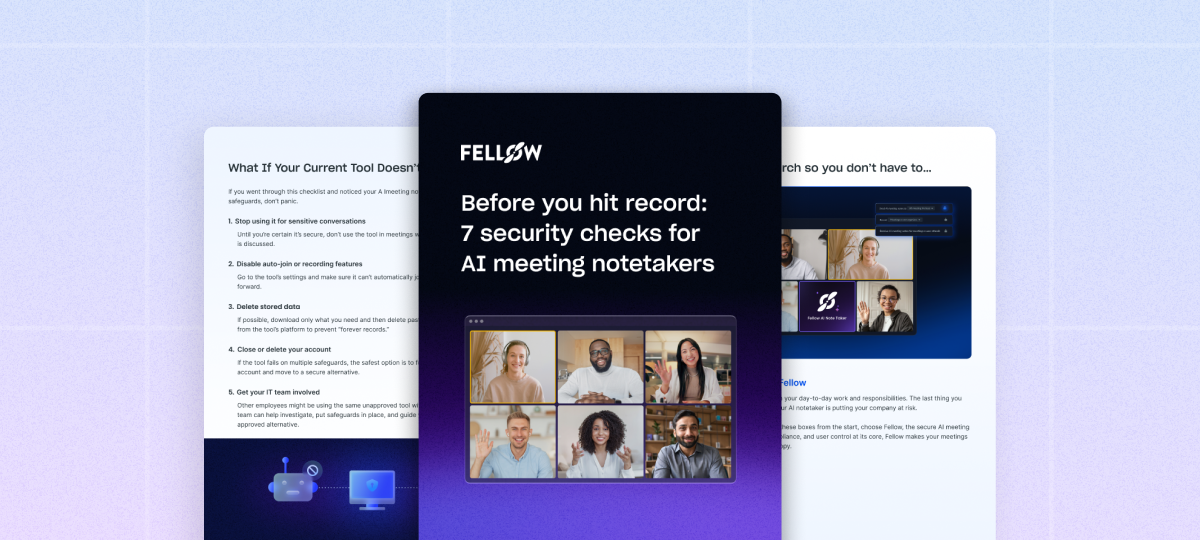Meetings don’t end once you’ve closed your laptop. The most impactful work often happens after the call ends, when it’s time to send a follow-up message. A well-written follow-up recap does more than summarize what was said: it drives alignment, reinforces priorities, and sets clear next steps.
Unfortunately, too many teams treat follow-up emails as an optional formality. The result? Action items fall through the cracks, accountability fades, and valuable insights get lost. But with the right approach, and the right AI meeting assistant, you can make follow-ups effortless, secure, and impossible to ignore.
Why Post-Meeting Follow-Ups Matter
Think of a follow-up as the bridge between conversation and action. Without it, meetings risk becoming unproductive status updates. With it, you:
- Keep everyone aligned on decisions.
- Capture and distribute action items.
- Build trust by showing participants their voices were heard.
- Reduce confusion about responsibilities and deadlines.
The challenge is that manually writing and sending recap emails is time-consuming. And using the wrong AI notetaker can put sensitive business data at risk. That is why more teams are exploring AI-powered tools that can handle this step securely.
The Secure Way to Automate Meeting Recaps
There are dozens of AI meeting assistants on the market, but not all are built with the same standards of security and trust. Many capture your conversations and send them to third-party servers without clear data protections. The most effective options combine accuracy, speed, and privacy.
One solution worth considering is Fellow’s AI Notetaker. It takes a security-first approach and provides:
- Automatic AI Recaps: Securely joins your meetings, recording, transcribing, and summarizing in real time.
- Built-In Privacy: Data remains under your control and is never sold or exploited.
- Seamless Distribution: Recaps, action items, and notes are sent directly to attendees via your calendar or preferred channel.
- No More Manual Work: Follow-up emails are generated instantly so you never worry about missing details.
This makes it easier for teams to focus on outcomes instead of admin tasks.
What Belongs in a Post-Meeting Follow-Up
Whether you automate with an AI assistant or draft your own, the most effective follow-up messages include:
- A clear subject line (e.g., “Recap: Product Launch Planning”)
- A brief thank you
- Key decisions made during the meeting
- Next steps and owners
- An invitation for questions or clarification
- A call to action (if further input or approval is needed)
Follow-Up Considerations by Meeting Type
Different meetings call for different styles of follow-up:
- Internal team meetings → Focus on alignment, decisions, and next steps.
- Sales meetings → Highlight listening skills, summarize needs, and drive next actions.
- Customer meetings → Capture pain points, reinforce solutions, and show follow-through.
- Interviews → Thank participants, recap discussions, and outline next steps.
Tools like Fellow make these follow-ups easy to generate automatically and securely, reducing the chance of missing important details.
Best Practices for Effective Follow-Up Emails
- Tailor your subject line so recipients instantly know the context.
- Express gratitude to build trust and goodwill.
- Reaffirm next steps with deadlines and owners.
- Proofread for clarity. AI helps, but the human touch still matters.
- Personalize where possible. Attention to detail pays off.
- Send quickly. Ideally within 24 hours, or use automation through an AI notetaker.
Top AI Meeting Assistants for Secure Follow-Ups in 2024
When it comes to meeting recaps, not every AI notetaker is created equal. Here are three that stand out:
Fellow Notetaker
Strongest option for teams that prioritize security and privacy. Provides automated recaps, action items, and distribution with enterprise-grade protections.
MeetGeek
A versatile integration tool that records, transcribes, and shares highlights across platforms like Slack and Notion.
Otter
Popular for its ease of use, though less transparent about long-term data handling.
If security is non-negotiable, Fellow is a clear leader. If integrations or analytics are your main need, other tools may be worth considering.
Post-Meeting Follow-Up Templates
Here are a few simple templates you can adapt, or let an AI notetaker generate automatically.
Simple Team Recap
Subject: Recap: [Meeting Title]
Hi Team,
Thanks for today’s discussion. Here are the highlights:
- Key decisions: [Insert]
- Next steps: [Insert]
- Owners: [Insert]
Please let me know if I missed anything. Full notes are attached.
— [Your Name]
Sales Prospect Recap
Subject: Next Steps: [Prospect Meeting]
Hi [Name],
Great meeting yesterday. Based on our discussion:
- Your main challenges: [Insert]
- How we can help: [Insert]
- Next steps: [Insert]
Looking forward to continuing the conversation.
— [Your Name]
Final Thoughts
Follow-ups are not just a courtesy. They are the key to turning conversations into outcomes. But in today’s AI-driven workplace, security and trust matter just as much as efficiency.
AI notetakers can remove the burden of manual recaps, but choosing the right one is critical. Fellow, for example, combines automation with a security-first design, making it a strong choice for teams that want productivity without compromise.
Want a smarter, safer way to manage follow-ups?
Explore secure AI notetakers and see how much time you can save while keeping your data private.
The most accurate and secure AI meeting notetaker
Record, transcribe and summarize your meetings with Fellow, the only AI meeting assistant built with privacy and security in mind.
Get started with Fellow todayLearn more


.webp)

